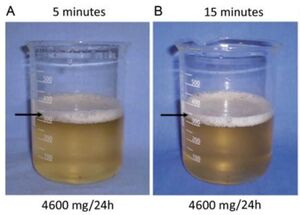Albuminuria
| Albuminuria | |
|---|---|
 | |
| Foamy and cloudy urine due to high protein including albumin[1] | |
| Specialty | Nephrology |
Albuminuria is a pathological condition wherein the protein albumin is abnormally present in the urine. It is a type of proteinuria. Albumin is a major plasma protein (normally circulating in the blood); in healthy people, only trace amounts of it are present in urine, whereas larger amounts occur in the urine of patients with kidney disease. For a number of reasons, clinical terminology is changing to focus on albuminuria more than proteinuria.[2]
Signs and symptoms
It is usually asymptomatic but whitish foam may appear in urine. Swelling of the ankles, hands, belly or face may occur if losses of albumin are significant and produce low serum protein levels (nephrotic syndrome).
Causes
The kidneys normally do not filter large molecules into the urine, so albuminuria can be an indicator of damage to the kidneys or excessive salt intake. It can also occur in patients with long-standing diabetes, especially type 1 diabetes. Recent international guidelines (KDIGO 2012) reclassified chronic kidney disease (CKD) based on cause, glomerular filtration rate category, and albuminuria category (A1, A2, A3).[2]
Causes of albuminuria can be discriminated between by the amount of protein excreted.
- The nephrotic syndrome usually results in the excretion of about 3.0 to 3.5 grams per 24 hours.[medical citation needed]
- Nephritic syndrome results in far less albuminuria.[medical citation needed]
- Microalbuminuria (between 30 and 300 mg/24h,[3] mg/l of urine[4] or μg/mg of creatinine[5]) can be a forerunner of diabetic nephropathy. The term albuminuria is now preferred in Nephrology since there is not a "small albumin" (microalbuminuria) or a "big albumin" (macroalbuminuria).[6] A1 represents normal to mildly increased urinary albumin/creatinine ratio (<30 mg/g or < 3 mg/mmmol); A2 represents moderately increased urinary albumin/creatinine ratio (30–300 mg/g or 3–30 mg/mmmol, previously known as microalbuminuria); and A3 reflects severely increased urinary albumin/creatinine ratio >300 mg/g or > 30 mg/mmol).[2]
Diagnosis
The amount of protein being lost in the urine can be quantified by collecting the urine for 24 hours, measuring a sample of the pooled urine, and extrapolating to the volume collected.
Also a urine dipstick test for proteinuria can give a rough estimate of albuminuria. This is because albumin is by far the dominant plasma protein, and bromophenol blue the agent used in the dipstick is specific to albumin.
Treatment
Though there is some evidence that dietary interventions (to lower red meat intake) can be helpful in lowering albuminuria levels,[7] there is currently no evidence that low protein interventions correlate to improvement in kidney function.[8] Among other measures, blood pressure control, especially with the use of inhibitors of the renin-angiotensin-system, is the most commonly used therapy to control albuminuria.
References
- ↑ Dantas, M; Barros Silva, GE; Moysés-Neto, M (June 2013). "Foamy urine in nephrotic syndrome". Clinical kidney journal. 6 (3): 341. doi:10.1093/ckj/sft018. PMID 26064498.
- ↑ 2.0 2.1 2.2 KDIGO (Kidney Disease Improving Global Outcomes (2013). "KDIGO 2012 Clinical Practice Guideline for the Evaluation and Management of Chronic Kidney Disease" (PDF). Kidney International Supplements. 3 (1): 1–150. Archived from the original (PDF) on 4 March 2016. Retrieved 5 February 2016.
- ↑ Page 291 Archived 2021-04-26 at the Wayback Machine in: Lee, Mary (26 February 2009). Basic Skills in Interpreting Laboratory Data. ISBN 978-1-58528-180-0. Archived from the original on 16 December 2019. Retrieved 23 May 2013.
- ↑ Person—microalbumin level (measured) Archived 2021-08-27 at the Wayback Machine at Australian Institute of Health and Welfare. 01/03/2005
- ↑ [1] Archived 2021-08-27 at the Wayback Machine Justesen, T.; Petersen, J.; Ekbom, P.; Damm, P.; Mathiesen, E. (2006). "Albumin-to-creatinine ratio in random urine samples might replace 24-h urine collections in screening for micro- and macroalbuminuria in pregnant woman with type 1 diabetes". Diabetes Care. 29 (4): 924–925. doi:10.2337/diacare.29.04.06.dc06-1555. PMID 16567839.
- ↑ KDIGO 2012. "Clinical Practice Guideline for the Evaluation and Management of Chronic Kidney Disease" (PDF). Archived from the original (PDF) on 2016-03-04.
{{cite journal}}: Cite journal requires|journal=(help) - ↑ de Mello, V. D. F. et al. "Withdrawal of red meat from the usual diet reduces albuminuria and improves serum fatty acid profile in type 2 diabetes patients with macroalbuminuria." American Journal of Clinical Nutrition 83.5 (2006): 1032.
- ↑ Pan Yu et al. "Low-protein diet for diabetic nephropathy: a meta-analysis of randomized controlled trials." American Journal of Clinical Nutrition 88 (2008): 660-666.
External links
| Classification |
|---|
| Wikisource has the text of the 1911 Encyclopædia Britannica article Albuminuria. |